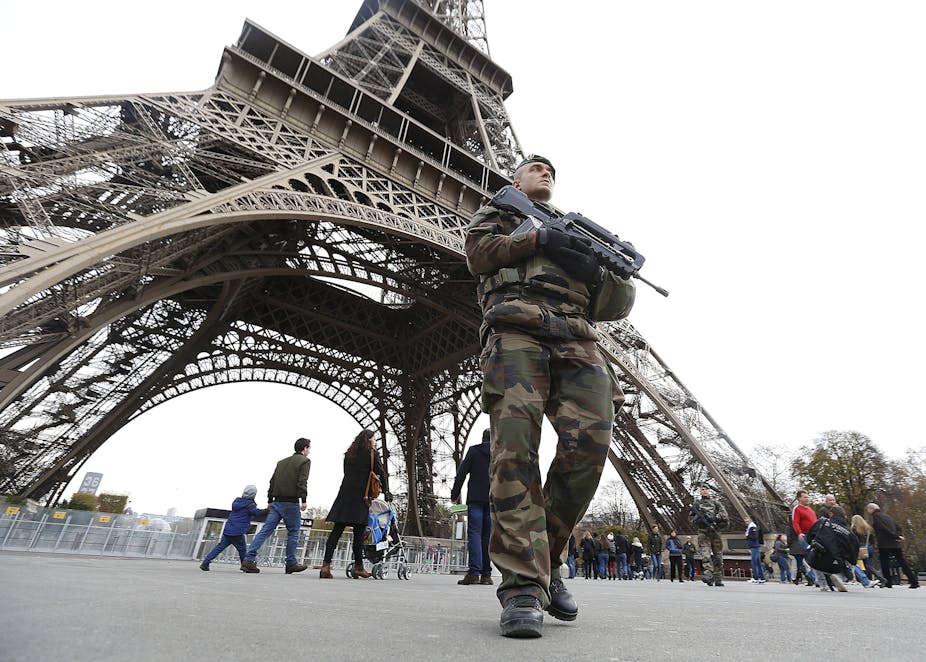The horror and scale of what has happened in Paris this weekend is utterly unprecedented. But like other global cities, the French capital is no stranger to terror attacks.
France’s history of terrorist violence extends back to the late 19th century, when anarchists committed bombings in the capital and even assassinated a president. The 20th century saw attacks perpetrated in the name of right wing, left wing, nationalist and fundamentalist religious causes.
This history should remind us that both France and democracies in general have long been the target of extreme factions who use violence to pursue their aims. And in recent French history, that violence – whether perpetrated by anarchists, communists, fascists, or religious fanatics – has been inherently unpredictable.
The challenge for the Republic and all democratic regimes is how best to deal with the threat of terrorism while remaining true to the values that terrorists wish to destroy.
While terror networks such as al-Qaeda and Islamic State (IS) may seem to have an exceptionally long reach, terrorism has historically been an international phenomenon. French anarchists, inspired by Russian counterparts, assassinated president Sadi Carnot in June 1894.

In 1937, police uncovered a plot to overthrow the democratic regime formulated by the extreme right-wing group Cagoule, which had received financial and material support from Mussolini’s regime in Italy. The Cagoule murdered specific antifascist opponents on the orders of Italy, as well as suspected deserters, informers and policemen.
Nor have international factors solely relied on home-grown terrorists. In 1934, Croatian nationalists assassinated King Alexander of Yugoslavia in Marseille; in October 1978, Palestinians fired on a plane from Paris bound for Israel. In the 1990s, the Algerian Groupe Islamique Armée mounted several attacks on the French mainland as the former French colony descended into civil chaos.
Long reach
During the 1950s and 1960s, the Algerian Front de la Libération Nationale (FLN) attacked French targets in North Africa and on the French mainland in the name of self-determination for Algeria. In response, the Organisation de l’Armée Secrète – founded by European settlers in the colony – bombed Algerian settlements and attempted to assassinate then president, Charles de Gaulle, on August 22 1962 to halt the move towards independence.
During the so-called Decade of Regicide at the end of the 19th century, anarchists assassinated more monarchs and heads of state than at any other time in history.

But others were not so selective. In February 1894, anarchist Emile Henry tossed a bomb into the crowded Café Terminus in Paris and fled. And while the FLN targeted police and army officers in its attempt to undermine the colonial state, it also planted bombs in cafes and bars to kill civilians.
In the wake of the assassination of the US president, William McKinley in 1901, Theodore Roosevelt described anarchist terrorists as “criminals against the human race”. At a League of Nations conference in 1937, terrorism was likewise portrayed as a threat to mankind itself – and it was France that proposed the Convention for the Prevention and Punishment of Terrorism, which was adopted by 24 countries but which never entered into force.
Peace, bread and liberty
The current threat from radical jihadist terrorism is dramatic, with political leaders around the world describing it as a threat to the fundamental values of civilisation. And the French Republic is itself premised on those values.
Following the November 13 attacks, the US president, Barack Obama, made common cause with France by saying that: “Paris itself represents the timeless values of human progress” – not a far cry from the campaign to defend the Republic from fascism in the mid-1930s, which proclaimed itself as in a fight to secure “peace, bread and liberty”.

